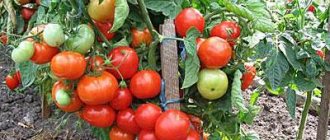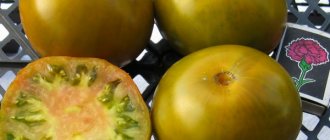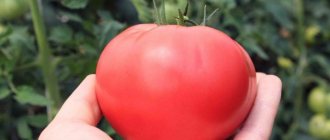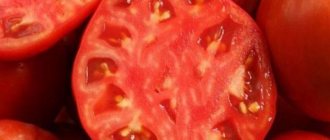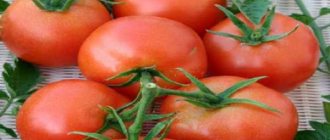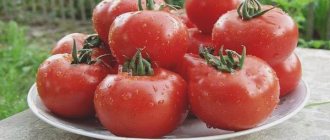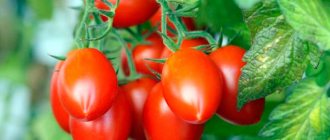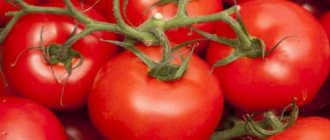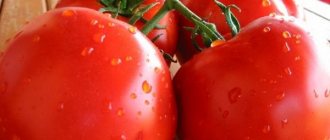With this tomato, every farmer can feel like a tomato magnate. Irina F1 is a strong, super-yielding hybrid. The embodiment of the best properties - endurance, stability, taste.
| Height | Landing location | Ripening time | Fruit color | Fruit size | Origin | Fruit shape |
| Medium height | Greenhouse, Open ground | Early ripening | Reds | Average | Hybrid | Round |
Tomato Irina: variety description
| Variety name | Irina |
| general description | Early ripening variety of determinate type |
| Originator | Russia |
| Ripening period | 93-95 days |
| Form | Flat-rounded, not ribbed |
| Color | Red |
| Average weight of tomatoes | 120 grams |
| Application | Universal |
| Productivity of the variety | 16 kg per square meter |
| Features of cultivation | Standard agricultural technology |
| Disease resistance | Resistant to many diseases |
Irina tomatoes are a first generation F1 hybrid; the breeders managed to include all the quality traits in it. Tomato hybrids are more resistant to adverse conditions and diseases, but have one drawback - the seeds cannot be used for planting .
The plant is determinate (has a final growth point, no need to “pin back”). Read about indeterminate varieties here. The type of bush is not standard. Stocky, persistent, about a meter high. The stem is strong, thick and well leafy with several simple type racemes. The leaf is medium-sized, dark green, typical “tomato” - wrinkled, without pubescence. The inflorescence has a simple structure, the intermediate type is the first inflorescence above the 6-7th leaf, the subsequent ones occur with an interval of 2 leaves, sometimes after 1 leaf. One inflorescence produces about 7 fruits. Pedicel with articulation.
Tomato Irina is an early ripening hybrid; the fruits begin to ripen 93 - 95 days after planting . It has excellent resistance to most tomato diseases - tobacco mosaic, Alternaria, Fusarium, late blight. Cultivation is carried out in greenhouses, greenhouses, under film and in open ground.
Characteristics
The shape is flat-round (flattened at the top and bottom), not ribbed. Size - about 6 cm in diameter, weighing about 120 g . The skin is smooth, dense, thin. Inside the fruit is fleshy, tender, juicy. The color of the fruit when unripe is pale green, when ripe it is dark red. No stains are observed.
You can compare the weight of fruits with other varieties in the table below:
| Variety name | Fruit weight |
| Irina | 120 grams |
| Apples in the snow | 50-70 grams |
| Favorite F1 | 115-140 grams |
| Alpatieva 905A | 60 grams |
| Tsar Peter | 130 grams |
| Pink flamingo | 150-450 grams |
| Peter the First | 250 grams |
| Tanya | 150-170 grams |
| Black Moor | 50 grams |
| Pink honey | 80-150 |
The taste is noted to be good, rich “tomato”, sweet (the amount of sugars is about 3%). There are a small number of seeds, placed in several chambers (more than 4). Dry matter content less than 6%. Stored in dry, dark places for quite a long time . It tolerates transportation without consequences for the condition of the skin and interior.
The Irina tomato variety was bred by breeders of the Russian Research Institute. Registered in the State Register of the Russian Federation for cultivation in garden plots in open ground and under film covers in 2001. Available for cultivation throughout the Russian Federation.
Universal in use, good both fresh (sliced, vegetable salads, sandwiches) and after heat treatment (stews, stews, soups). Suitable for canning, does not lose shape due to high density . Suitable for the production of tomato paste and sauces, juice production is possible.
Productivity is high - up to 9 kg per plant (about 16 kg per m2), up to 5 kg per plant in the first weeks in greenhouses without additional heating. In heated greenhouses, larger fruits are possible; in open ground, accordingly, smaller fruits are possible. Fruit sets well in cold weather.
You can compare the yield of this variety with others in the table below:
| Variety name | Productivity |
| Irina | 16 kg per square meter |
| Golden Stream | 8-10 kg per square meter |
| Rosemary pound | 8 kg per square meter |
| The Lazy Man's Miracle | 8 kg per square meter |
| Honey-sugar | 2.5-3 kg per bush |
| Sanka | up to 15 kg per square meter |
| Demidov | 1.5-4.7 kg per square meter |
| Locomotive | 12-15 kg per square meter |
| Dimensionless | 6-7.5 kg per bush |
| President 2 | 5 kg per bush |
Application
The tomato variety Irina F1 is universal in use. It is very tasty and suitable for fresh consumption, adding to salads and slicing. Tomatoes do not lose their taste and quality characteristics even after heat treatment, so they can be used in preparing hot dishes. Also suitable for canning, as it does not crack and retains its shape. Tomatoes are suitable for processing and making paste, sauce from juice.
Watch the video! Tomato Irina
Advantages and disadvantages
The Irina tomato variety has the following advantages:
- early ripeness;
- bountiful harvest;
- high taste qualities;
- resistance to weather conditions - fruit sets at low temperatures;
- immunity to many diseases;
- good storage;
- transportability.
No deficiencies were identified . Among the specific features, one can note only the need for careful care.
What is remarkable about a hybrid: pros and cons
The advantages of this variety of tomato outweigh its disadvantages. Here are the main advantages inherent in this plant:
- abundant plant yield - per 1 sq. m can grow up to 20 kg of vegetables;
- early ripening;
- high level of resistance to diseases and pests characteristic of tomatoes;
- excellent tolerance to long-term storage and transportation;
- rich taste of the fruit;
- resistance to low temperatures;
- no need for pinching.
The negative characteristics of the variety mainly include agrotechnical difficulties, since this species is very demanding in terms of care and has its own characteristics of growth and development. Seeds removed from tomatoes cannot be used to grow new plants. Another significant disadvantage is the rapid deterioration in the quality of the fruit after it is damaged as a result of an impact.
Features of cultivation
Tomatoes Irina f1 can be grown in seedlings. The process begins in the second half of March.
Seeds are disinfected in a weak solution of potassium permanganate, placed in heated soil at a depth of about 2 cm. The distance between plants is approximately 2 cm. The soil for seedlings must also be disinfected and steamed. You can use growth stimulants, and plant the seedlings in special mini-greenhouses. Picking is carried out when the plants have 2 full leaves .
Watering is necessary without getting water on the leaves. After 50-60 days it is possible to plant it in a permanent place in a greenhouse, in open ground - a week later, the plants should have 6 leaves.
Before planting in the ground, you need to harden off the plants. Planted in a checkerboard pattern, the distance between plants is 50 cm. It requires the formation of a bush of 1 stem, pinching every one and a half weeks.
Loosening, mulching, fertilizing every 10 days. Watering at the root. Tying is required on individual supports in several sections of the stem.
The following are usually used as fertilizers for tomatoes:
- Organic.
- Mineral complexes.
- Yeast.
- Iodine.
- Hydrogen peroxide.
- Ammonia.
- Ash.
- Boric acid.
Recommendations for growing tomatoes
The agricultural technology of this variety is standard, but to get a good result, you will have to work hard.
Tomato productivity indicators depend on various conditions, including the type of seedlings. Strong and healthy seedlings take root much better in a permanent place, bear fruit abundantly, do not get sick and are pleasing to the gardener’s eye.
- Seeds (if there is no information on the package) are disinfected in a solution of potassium permanganate, soaked in any growth stimulants, and then germinated.
- Prepare a high-quality nutrient mixture for plants, boxes, pots, cups.
- Determine the place indoors where the tomatoes will have to grow and gain strength before being planted in the beds or in the greenhouse.
Sowing for seedlings - mid or late March; at earlier times, the seedlings of this tomato stretch out and outgrow.
ON A NOTE! The best age of seedlings when planting is 55-60 days.
First, sow the seeds in common boxes or containers, then plant them in separate containers. The soil must be balanced in all components, loose, nutritious, and moisture-permeable.
Fertilizing seedlings – 2 times (you don’t have to do this if you know that the soil mixture contains enough nutrition for the plants). Watering is moderate, as the earthen coma dries out.
The plant is picked at the stage of two true leaves; after the procedure, it is necessary to shade the seedlings for 1-2 days from the sun. Planting time in open ground is at the end of May or beginning of June, in greenhouses - May. The exact timing is determined based on the weather conditions of the area, as well as the place of cultivation - in greenhouses or in the garden.
Diseases and pests
As already mentioned, the variety is resistant to many tomato diseases. However, information about the main greenhouse diseases and how to combat them may be useful to you. From the articles on our website you will learn which varieties do not suffer from late blight, how to protect plants from this disease, and what verticillium wilt is.
When grown in open ground, plants can be threatened by a variety of pests: Colorado potato beetle, spider mites, slugs, aphids. Microbiological preparations or insecticides will help in the fight against them.
Tomato Irina f1 is a high-yielding hybrid that will bring only the joy of growing to gardeners.
